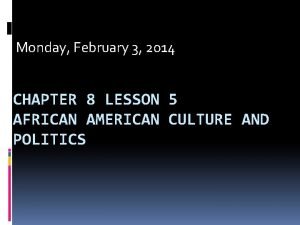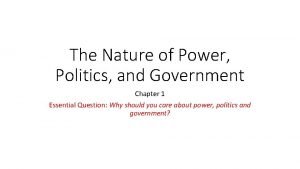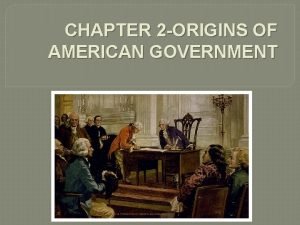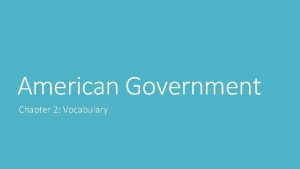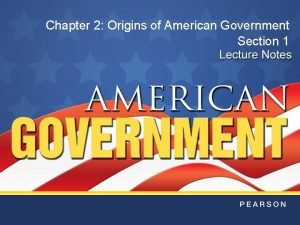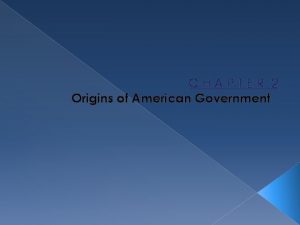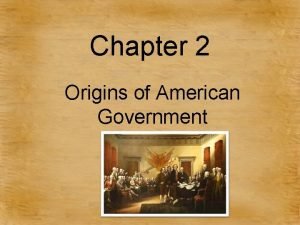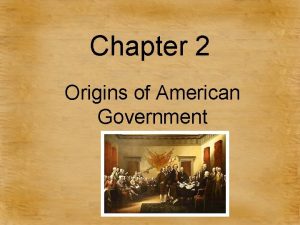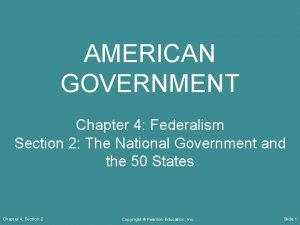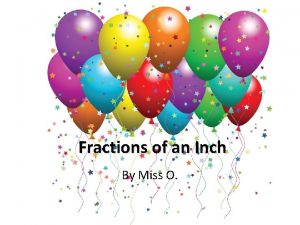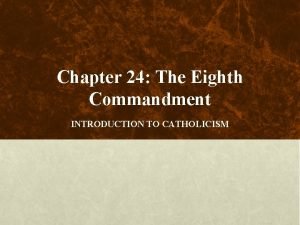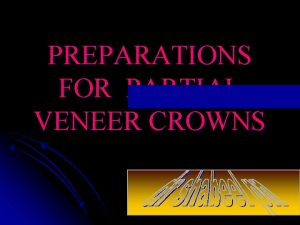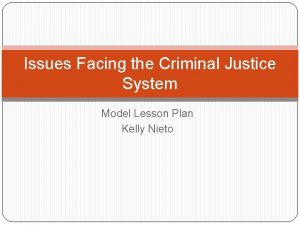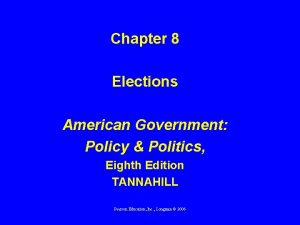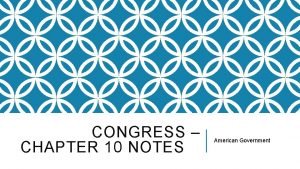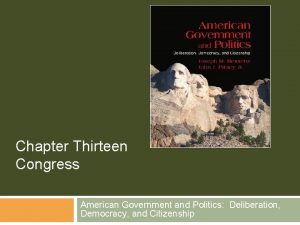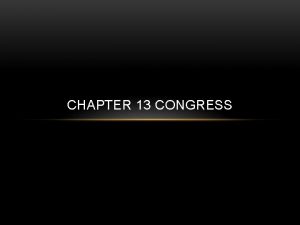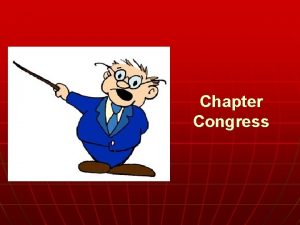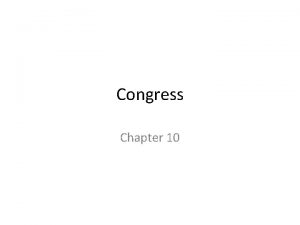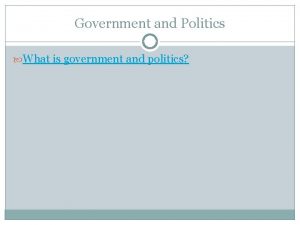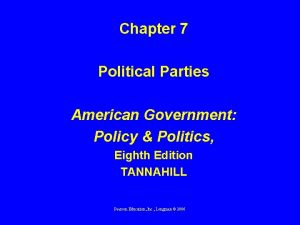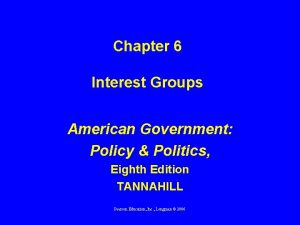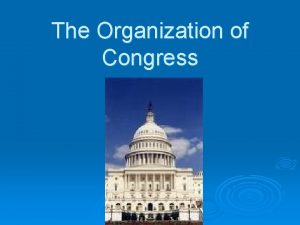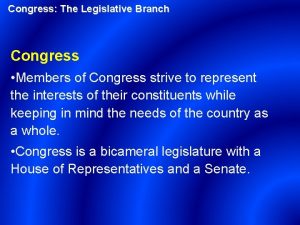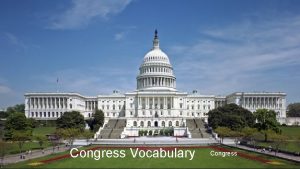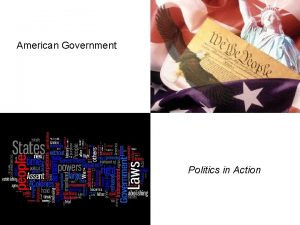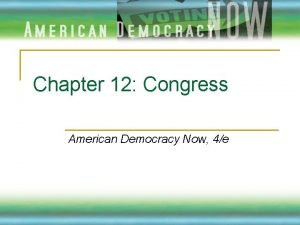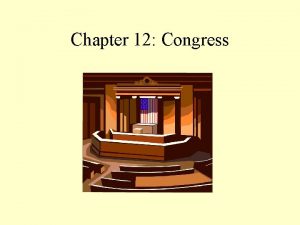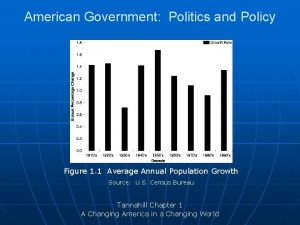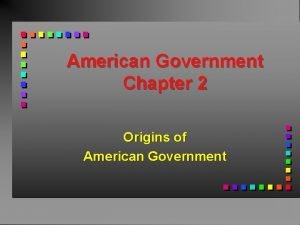Chapter 9 Congress American Government Policy Politics Eighth






















- Slides: 22

Chapter 9 Congress American Government: Policy & Politics, Eighth Edition TANNAHILL Pearson Education, Inc. , Longman © 2006

In This Chapter We Will Cover: • • Bicameralism Membership Organization Development of the modern Congress • The legislative process • Analyzing the legislative process Pearson Education, Inc. , Longman © 2006

Bicameralism • Bicameralism is the division of the legislative branch of government into two chambers. The United States’ bicameral system is composed of a Senate and a House of Representatives. Pearson Education, Inc. , Longman © 2006

U. S. Bicameralism • Senate • House of Representatives – Since 1911, there have been 435 voting members in the U. S. House. – The size of a state’s delegation depends on the state’s population. – Each state elects two senators. – Originally senators were selected by state legislatures; however, since the ratification of the 17 th Amendment (1913) senators are popularly elected. – Senators serve six-year terms. – Terms of the membership are staggered. Pearson Education, Inc. , Longman © 2006

Membership • Profile of the membership – The 109 th (2005) Congress is ethnically quite diverse. • Diversity in the House – – – 65 women 42 African Americans 24 Latinos 3 Asian Americans 1 Native American, 1 Asian Indian American, 2 openly gay men, and 1 lesbian • Senate diversity – – 14 women 2 Asian Americans 2 Latinos One African American Pearson Education, Inc. , Longman © 2006

Membership – Members of Congress are older, richer, and better educated than the average Americans. • The average in the House is 54, in the Senate it is 60. • At least 50 members are worth over $2. 5 million. • In 2005, almost every member of Congress was a college graduate. Pearson Education, Inc. , Longman © 2006

Membership • Compensation – Rank and file members of Congress make $158, 000. – In 1989, lawmakers get an annual cost of living raise unless both the House and Senate vote to block it. • Personal Styles – Traditionally the job of a member of Congress was viewed as a career. – Today many members see serving in Congress as a stepping stone to higher office. • Membership Turnover – While incumbents are rarely defeated, turnover is relatively high. Pearson Education, Inc. , Longman © 2006

Organization • Senate Leadership – Senate president pro tempore – Senate Majority Leader • House Leadership – Speaker of the House – House Majority Leader Pearson Education, Inc. , Longman © 2006

Organization • Committee and Subcommittee Organization – Standing committees are permanent committees with authority to draft legislation in a particular area. – Select committees are established for a limited time only. – Joint committees include members from both houses of Congress. Pearson Education, Inc. , Longman © 2006

The Development of the Modern Congress • Pre-Civil War – Congress was a part-time legislative body, normally meeting for less than six months per year. • Civil War to 1910 s – Congress became a professional body. – Leadership and committees became more important. • 1910 s to 1970 s – Congress grew very decentralized. – Committees and chairs became autonomous power centers. Pearson Education, Inc. , Longman © 2006

The Development of the Modern Congress • Mid-1970 s – Critics charged Congress had become undemocratic by relying heavily on seniority and party affiliation. – Critics also objected to the use of unrecorded votes and deal making outside of the public eye. – Reforms in the 70 s made Congress more open, representative, and democratic, but also less efficient. • Since 1970 s – Steps have been taken to modify the impact of the 70 s reforms. Pearson Education, Inc. , Longman © 2006

The Legislative Process • Origin and Introduction – In 2003, members of Congress introduced 7, 014 bills and resolutions. • A bill is a proposed law. • A resolution is a legislative statement of opinion on a certain matter. Pearson Education, Inc. , Longman © 2006

The Legislative Process • Committee and Subcommittee Action – Once a bill or resolution is introduced, it is assigned a number and referred to committee. Pearson Education, Inc. , Longman © 2006

The Legislative Process Pearson Education, Inc. , Longman © 2006

The Legislative Process (continued) Pearson Education, Inc. , Longman © 2006

The Legislative Process • Floor Action – The process for moving measures from committee to the floor varies, depending on the type of measure. • Appropriation bills are legislative authorizations to spend money. Sometimes the leadership brings these bills to the floor after little or no committee consideration • Most measures in the House go to the Rules Committee after having cleared standing committees. The Rules Committee determines the rules under which a bill can be debated, amended, etc. Pearson Education, Inc. , Longman © 2006

Floor Action • Senate • House – The Speaker has tremendous power because of control over the Rules Committee. • The Speaker personally picks a majority of the members on the Rules Committee. • Once a measure reaches the House floor, debate is typically very tightly structured. – Measures can reach the floor by a unanimous consent agreement. – Nongermane amendments are allowed, when they stop a bill they are called killer amendments. – Filibusters can delay a vote indefinitely, unless cloture is invoked. Pearson Education, Inc. , Longman © 2006

Floor Action • Conference Committee Action – Conference committees negotiate differences between House and Senate versions of legislation. – Though rarely used, conference committees are typical for major legislation. • Presidential Action – A veto is refusal to approve. – Pocket vetoes allow a measure to die without signature after Congress has adjourned. Pearson Education, Inc. , Longman © 2006

Analyzing the Legislative Process • Political Ideology – The personal views of members of Congress have a major impact on legislative policymaking. • Political Party – Has its greatest influence on close votes, procedural votes, and matters that party leaders identify as key. • Constituency – Most members of Congress believe that they have a responsibility to “vote their district. ” Pearson Education, Inc. , Longman © 2006

Analyzing the Legislative Process • Leadership – Having few formal powers, congressional leaders must resort to bargaining and persuasion. • Interest Groups – Groups hope to gain access to gather information so they can determine the impact of propose policy. • The White House – The president is a key player in congressional policymaking. Presidents use their influence to round up votes on the floor. Pearson Education, Inc. , Longman © 2006

Concluding Review Questions • How have the differences in constitutional structures and responsibilities of the House and Senate affected the development of the two chambers? • Does the membership of Congress reflect the diversity of American society? • How are party leaders chosen and what role do they play in the legislative process? Pearson Education, Inc. , Longman © 2006

Concluding Review Questions • How are committees organized? • What are the steps in the legislative process? • How much influence do interest groups have in the legislative process? • What role does Congress play in the policymaking process? Pearson Education, Inc. , Longman © 2006
 Lesson 5 african american culture and politics
Lesson 5 african american culture and politics Whose government politics populists and progressives
Whose government politics populists and progressives Us government unit 1 study guide
Us government unit 1 study guide The nature of power politics and government
The nature of power politics and government Chapter 2 american government
Chapter 2 american government Chapter 2 origins of american government vocabulary
Chapter 2 origins of american government vocabulary Chapter 2 origins of american government answer key
Chapter 2 origins of american government answer key Chapter 2: origins of american government worksheet answers
Chapter 2: origins of american government worksheet answers Chapter 2 lesson 1 government in colonial america
Chapter 2 lesson 1 government in colonial america Chapter 2 origins of american government
Chapter 2 origins of american government American government chapter 4
American government chapter 4 Anagram of eighth
Anagram of eighth Psychology eighth edition david g myers
Psychology eighth edition david g myers Matching planet rings
Matching planet rings Quarter inch fraction
Quarter inch fraction Psychology eighth edition david g myers
Psychology eighth edition david g myers The fifth, sixth, seventh, and eighth amendments protect *
The fifth, sixth, seventh, and eighth amendments protect * What is the eighth commandment catholic
What is the eighth commandment catholic What is the eighth wonder
What is the eighth wonder Partial veneer crown preparation
Partial veneer crown preparation Eighth amendment excessive bail
Eighth amendment excessive bail Eighth letter of the alphabet
Eighth letter of the alphabet Criminal justice lesson
Criminal justice lesson
